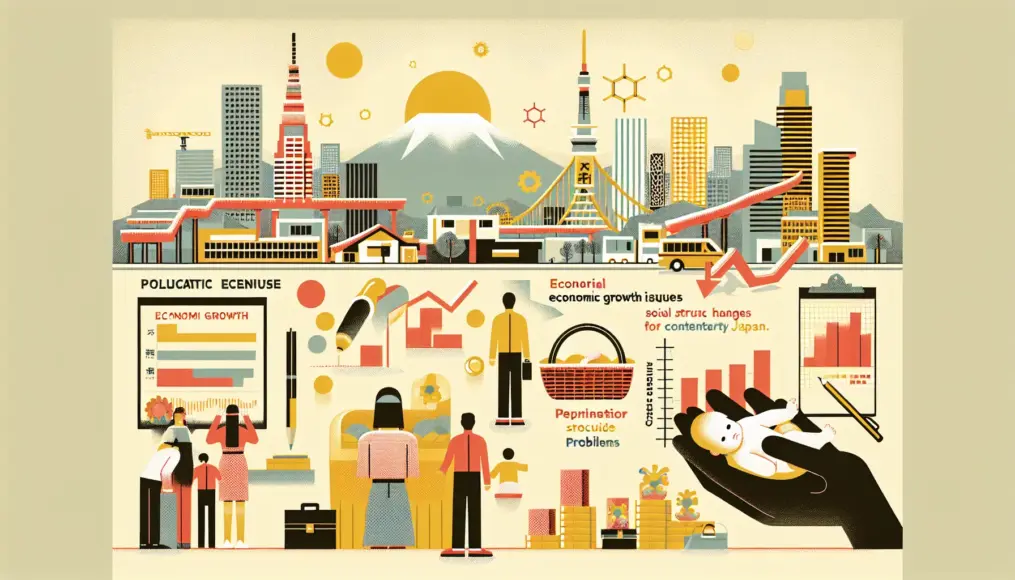The decline in birth rates is having a profound effect on our society and economy. This issue manifests in tangible ways, such as labor shortages and a shrinking consumer market, directly affecting our daily lives. Gaining a deep understanding of this problem is crucial for building a sustainable future.
In this article, we will explore the background of declining birth rates, the implications it carries, and the current measures being taken to address this issue. To tackle the challenges posed by decreasing birth rates, it is essential for each of us to be aware and engaged. Let’s take a closer look at the potential solutions.
- Exploring the economic implications of declining birth rates
- Considering the changes in social structure and their significance
- Current challenges in addressing the issue of declining birth rates
The Impact of Declining Birth Rates on Economic Growth
Japan’s declining birth rate is having a serious impact on its economic growth. Notably, the shrinking workforce and consumer market pose significant threats to the country’s sustainable development. Understanding these issues allows us to examine the economic repercussions of declining birth rates and the urgent need for solutions.
In this section, we’ll take a closer look at the labor shortage caused by the declining birth rate and its economic consequences. We will also explore how the shrinking consumer market affects businesses and households, and what the future may hold.
Labor Shortage and Its Effects
The declining birth rate has made it increasingly difficult to secure a workforce. As the number of workers decreases, companies face labor shortages that may lead to reduced productivity and challenges in maintaining operations. This could result in a slowdown of overall economic growth.
Moreover, a labor shortage can lead to rising wages. Companies may have no choice but to offer higher salaries to attract the limited talent available. If this situation persists, it could strain businesses, resulting in decreased investment and job cuts.
- The link between declining birth rates and labor shortages
- The impact of labor shortages on corporate productivity
- The risks of wage increases for the overall economy
Shrinking Consumer Market
The declining birth rate also affects the consumer market. As the population decreases, the number of consumers shrinks, which can lead to lower sales for businesses. There are particular concerns regarding the diminishing population of younger generations, which could further narrow the future consumer market.
Additionally, a shrinking consumer market can dampen companies’ willingness to enter new markets or invest in growth. In a contracting market, businesses may become more risk-averse, making it challenging to invigorate the economy.
- The decline in consumer numbers due to declining birth rates
- The risk of decreased sales for businesses
- The reduced willingness to enter new markets or invest
Shifts in Social Structure and Declining Birth Rates
The decline in birth rates is not just a matter of fewer babies being born; it has profound implications for our social structure. In particular, the shift towards an aging society is reshaping families and communities, leading to a variety of challenges. Additionally, changes in family dynamics are closely linked to declining birth rates, necessitating a response to the evolving needs of society.
In this section, we will explore the changes in social structure that are occurring alongside declining birth rates. Let’s take a closer look at how the transition to an aging society and shifts in family forms are influencing this phenomenon.
Transition to an Aging Society
The simultaneous progression of declining birth rates and an aging population presents a significant social issue. As the number of children born decreases, the proportion of elderly individuals is rising, altering the overall age composition of society. In this context, the burden on social security systems—such as pensions, healthcare, and long-term care—intensifies, posing major challenges for both the government and local communities.
While an aging society can bring various benefits, it also brings harsh realities, such as declining economic activity and labor shortages. With an increasing number of elderly individuals, the burden on younger generations to provide support grows heavier, highlighting the need for effective measures to create a sustainable society.
- Current state of an aging society
- Impact on social security systems
- Increased burden on younger generations
Changes in Family Structure
The decline in birth rates is also affecting family structures. As nuclear families become more prevalent, there is a rise in households without children and single-parent families. These changes impact the support systems within families and the connections in local communities, leading to an increase in isolated individuals.
Moreover, the roles and values associated with families are evolving. In the past, raising children was seen as a primary focus, but there is now a stronger emphasis on individual lifestyles and careers. This shift in values may further encourage declining birth rates.
- Rise of nuclear families
- Increase in childless households
- Changes in family roles and values
Current Status and Challenges of Measures Against Declining Birth Rates
As the birth rate continues to decline, both the government and private sector are implementing a variety of measures. These initiatives aim to improve birth rates, but they also come with their own set of challenges and limitations. To effectively tackle the issue of declining birth rates, a multifaceted approach is essential.
In this section, we will take a closer look at the government’s strategies to address the declining birth rate and assess their effectiveness. We will also consider the role of the private sector and how their efforts contribute to combating this issue.
Government Initiatives and Their Effectiveness
The government has introduced several policies as part of its efforts to counter declining birth rates. These include financial support for raising children, improvements to childcare facilities, and parental leave systems. The goal of these measures is to alleviate the financial burden on families raising children and lower the barriers to having kids.
However, the effectiveness of these initiatives has its limits. In many cases, financial assistance alone does not yield significant results, highlighting the need for a reevaluation of societal values and work styles. In fact, there are numerous regions where birth rates have not improved, indicating that further action is required.
- Specific Government Measures Against Declining Birth Rates
- Effectiveness and Limitations of Policies
- The Need to Reassess Societal Values
The Role of the Private Sector
The private sector also plays a crucial role in addressing declining birth rates. Companies are working to create a more accommodating environment for their employees by enhancing parental leave policies and introducing flexible work arrangements. Such initiatives contribute to making workplaces more appealing, particularly for younger generations.
Moreover, local businesses and organizations host parenting support events and community gatherings, which help strengthen the ties between families and the community. These private sector efforts are expected to enhance the overall effectiveness of measures against declining birth rates.
- Parental Support Programs in Private Companies
- Creating a Work Environment that Supports Families
- Initiatives to Strengthen Community Connections
Future Prospects and Possibilities
The declining birthrate is a pressing issue that has significant implications for our future. However, by implementing appropriate measures, we also have the potential to build a sustainable society. In the years to come, we may see the emergence of new social models that leverage changes in population dynamics. This section will explore the path toward a sustainable society and propose ideas from an international perspective.
As the birthrate continues to decline, it’s essential for us to embrace new values and lifestyles. Doing so will help illuminate a pathway toward a better future.
The Path to a Sustainable Society
To realize a sustainable society, it’s crucial to view the declining birthrate not just as a challenge but as an opportunity to rethink the structure of our society. For instance, by utilizing the knowledge and experience of older generations, we can invigorate our local communities. Additionally, creating an environment where young people can actively participate in society will contribute to building a sustainable future.
Moreover, advancements in technology are providing us with more solutions to address labor shortages. The integration of automation and AI allows us to carry out tasks efficiently, even with fewer hands on deck. These initiatives will be key in mitigating the impacts of declining birthrates while working towards a sustainable society.
- The Importance of Viewing the Declining Birthrate as an Opportunity
- Building a Society that Utilizes the Knowledge of Older Generations
- Enhancing Efficiency through Technological Integration
Proposals from an International Perspective
The issue of declining birthrates is not unique to Japan; it is a phenomenon observed worldwide. Learning from both the successes and failures of other countries can greatly inform our policy-making. By incorporating an international perspective, we can explore effective strategies.
For example, Nordic countries maintain relatively high birthrates thanks to strong parental support and the promotion of gender equality. By referencing the initiatives in these countries, Japan might consider implementing similar policies. Additionally, fostering international cooperation to share and learn from each other’s approaches is vital.
- The Importance of an International Perspective
- Leveraging Success Stories from Nordic Countries
- Sharing Knowledge through International Cooperation
Conclusion
The declining birthrate is a serious issue that significantly impacts Japan’s economy and society. We see its effects manifesting in various ways, such as labor shortages, a shrinking consumer market, and a shift towards an aging population. However, by fostering collaboration between the government and the private sector, we can pave the way towards a sustainable society.
Moreover, incorporating an international perspective into our approach to tackling the declining birthrate will be crucial for success. By looking at successful case studies from Nordic countries and sharing insights from various nations, we may be able to develop effective policies and initiatives. It’s vital that each of us becomes aware of this issue and takes action.
- The declining birthrate has a significant impact on the economy and society.
- Collaborative efforts are essential for achieving a sustainable society.
- Formulating policies with an international perspective is important.
The declining birthrate is a critical theme that affects our future. We invite you to share your thoughts and opinions in the comments!



Comment